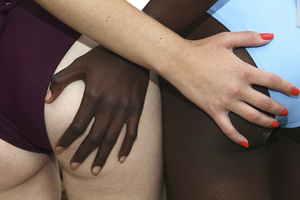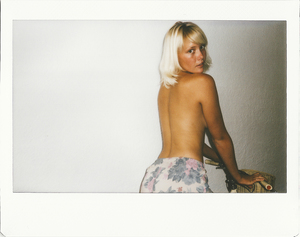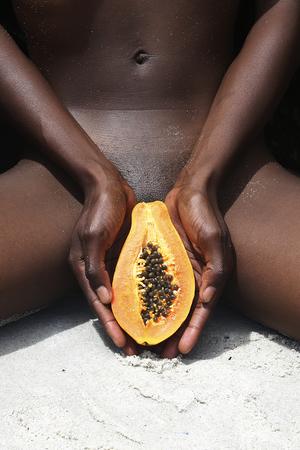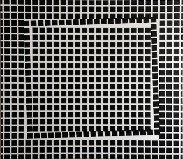© ANNE BARLINCHKOFF Images , used with permission
In the Name of Love
by Jean-Paul Gavard-Perrett
Contributing Columnist
With translations by Helene Gaillet de Neergaard
Often barefooted, Anne Barlinckoff’s models remain elegant, soft charming queens without an edge of showing off. Unbeknownst to herself, the artist captures them with a rare sensibility and magnetism. From their warm bodies emanate barely a suggestive caress at sunrise. Sometimes like a tiny shell gleaned from the sand, a space where water could not be more pure, captured in a bare hand. Anne Barlinchkoff wishes to present herself as controversial, but stands rather as a referee of reality. Only modesty and audacity are clear. And of course love, the fundamental gift of the life and creativity of this Netherlands artist.
Souvent pieds-nus, es modèles d’Anne Barlinckhoff demeurent élégants, elles sont de petites reines mais ne le montrent pas. Douce sans le savoir l’artiste les saisit avec une sensibilité et un magnétisme rares. De leur buisson ardent elle ne suggère que la caresse de l’aube. C’est parfois un grigri glané à fleur de sable là où l’eau ne peut pas être plus claire et à portée de mains nues. Anne Barlinckhoff aime à se présenter comme vénéneuse mais elle reste plutôt l’arbitre du réel. Seuls comptent la pudeur et l’audace. Et l’amour surtout – donnée fondamentale de la vie et l’œuvre de l’artiste néerlandaise.
Anne Barlinchkoff : « Fresh Cotton Calendar – Group Show”, Fresh Cotton HQ, Amsterdam et “Beth and Cactus”, Libertine Gallery, Amsterdam.
Jean-Paul Gavard-Perret: What makes you get up on morning?
Anne Barlinchkoff: Sunshine and love. And of course on a rainy day I can be very excited too or sometimes I just love to stay in bed.
 Q: What happened to your dreams as child?
Q: What happened to your dreams as child?
A: The most important one came true, I love myself. I have people around me that I love and the other way around. And beautiful people keep entering my life.
Q: What did you give up?
A: I gave up on the people that let me down. And look what I got in exchange, love.
Q: Where do you come from?
A: I come from a troubled past and it made me the person who I am today and I’m very happy with that.
Q: What is the first image you remember ?
A: Most probably it was of my cat in summer in the garden full of flowers.
Q: And the first book ?
A: I forgot the title, but it was about a boy who always got bullied at school until one day he won the competition and people looked at him differently and suddenly got empathy for him.
Q: What distinguishes you from other artists?
A: Maybe it’s almost an act out of love and the camera just happened to be there. Sharing my trust and love with others while making my work is passion. I exactly don’t consider it as working at all. It’s more like a trust project which turns out into love and images.
Q: Where do you work and how?
A: I work everywhere. I have a deep love for this planet, so I love to shoot in nature. It’s if it feels more connected in nature. I lived for over half a year in South Africa and made so much work between the sand, flowers and mountains.
Q: To whom do you never dare to write ?
A: No idea. I guess because I don’t have a reason not to dare.
Q: What music do you listen ?
A: All kinds, depending on what mood I am. Love experimental, new and upcoming things.
Q: What is the book you love read again?
A: ‘Just Kids’ by Patti Smith.
 Q: When you look yourself in a mirror who do you see?
Q: When you look yourself in a mirror who do you see?
A: I see a very strong person, still loving and never giving up.
Q: What city or place has value of myth for you?
A: Places where my heart and memories are.
Q: What are the artists you feel closest with?
A: Artists that are as passionate as I am, they that I feel connected with. You know when you and you’re best friend say the exact same thing at the exact same time. Or sometimes by just looking in each others eyes and have that feeling of instant understanding. I feel that with my loved ones but also with the works of Helmut Newton, Robert Mapplethorpe and Pablo Picasso, all Scorpios like me.
Q: What film makes you cry ?
A: I dropped some tears watching ‘Into The Wild’. There’s more movies, but sometimes you get more emotional depending on how you feel and how connected you feel at that time. I think I also shed a tear when I saw ‘Full Metal Jacket’ for the first time.
Q: What would you like to receive for your birthday?
A: Cuddles with all the people I love.
Q: What do you inspire the sentence of Lacan: “Love is giving something that we don’t have to someone who does not want”?
A: It’s the unexpected thing of love. We all need it somehow. And it’s most beautiful thing to give and receive even if you think it’s not needed.
Q: And W. Allen: “The answer is Yes but what was the question?”
A: Do you (wanna learn to) love yourself? Will love keep you going? Is nature part of us? Is sex important in a love life? Shall we keep loving forever?
The Rule and the Exception
Following her recent exposition at the Kunsthalle Palazzo de Liestal in Switzerland, and for her third show at the Galerie Alberta Pane in Paris, the Austro-Italian artist Esther Stocker is offering new paintings and sculptures as well as a very original exhibit.
Fascinated by the “shortcomings of precision,” the artist confounds rules and regulations with infinite flexibility. We discover this strategy in both her paintings and her abstract sculptures. Her formal grids, once formatted by the precursors Mondrian and Malevich, with their straight black or white lines, horizontal or vertical, are laid as an artificial foundation to move them away from a realistic world or object. Her grids are constructed, with the aid of Scotch masking tape (to protect their shape during construction), to offer a dimension with an unstable equilibrium.
Indeed, the artiste modifies her basics by line interruptions or by geometric breaks. They are then placed on walls, ceiling or on the floor. The onlooker finds himself suddenly floating in a series of illusions. To speak of this variable geometric artwork, Esther Stocker uses her own terms, such as “visual noises.” Rather than project harmony, which would create a visual “sound,” she superimposes a perceptual dissonance.
Between its normal rigidity and its circuitousness, this spatial geometry never ceases to stagger, to disappear and to be reborn in an imaginary dream which transcends the usual standards accepted within the fundamentals of abstract art.
About the Author and Translator
Translator Hélène Gaillet de Neergaard is author of “I WAS A WAR CHILD” Memoir of World War II. She was nominated for the PushCart Prize 2015. You can read more about her in About Us. http://www.iwasawarchild.com
***
Jean-Paul Gavard-Perret is the On Location/France contributing editor. You can read more about him in About Us.


Recent Comments